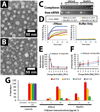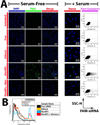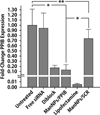Macrophage-specific RNA interference targeting via "click", mannosylated polymeric micelles
- PMID: 23331322
- PMCID: PMC3595119
- DOI: 10.1021/mp300434e
Macrophage-specific RNA interference targeting via "click", mannosylated polymeric micelles
Abstract
Macrophages represent an important therapeutic target, because their activity has been implicated in the progression of debilitating diseases such as cancer and atherosclerosis. In this work, we designed and characterized pH-responsive polymeric micelles that were mannosylated using "click" chemistry to achieve CD206 (mannose receptor)-targeted siRNA delivery. CD206 is primarily expressed on macrophages and dendritic cells and upregulated in tumor-associated macrophages, a potentially useful target for cancer therapy. The mannosylated nanoparticles improved the delivery of siRNA into primary macrophages by 4-fold relative to the delivery of a nontargeted version of the same carrier (p < 0.01). Further, treatment for 24 h with the mannose-targeted siRNA carriers achieved 87 ± 10% knockdown of a model gene in primary macrophages, a cell type that is typically difficult to transfect. Finally, these nanoparticles were also avidly recognized and internalized by human macrophages and facilitated the delivery of 13-fold more siRNA into these cells than into model breast cancer cell lines. We anticipate that these mannose receptor-targeted, endosomolytic siRNA delivery nanoparticles will become an enabling technology for targeting macrophage activity in various diseases, especially those in which CD206 is upregulated in macrophages present within the pathologic site. This work also establishes a generalizable platform that could be applied for "click" functionalization with other targeting ligands to direct siRNA delivery.
Conflict of interest statement
Figures







References
-
- Kindt TJ, Goldsby RA, Osborne BA, Kuby J. Kuby immunology. 6th ed. W.H. Freeman; New York: 2007. p xxii, 574, A-31, G-12, AN-27, I-27 p.
-
- Lewis CE, Pollard JW. Distinct role of macrophages in different tumor microenvironments. Cancer Res. 2006;66(2):605–612. - PubMed
-
- Dirkx AE, Oude Egbrink MG, Wagstaff J, Griffioen AW. Monocyte/macrophage infiltration in tumors: modulators of angiogenesis. J Leukoc Biol. 2006;80(6):1183–1196. - PubMed
-
- Fire A, Xu S, Montgomery MK, Kostas SA, Driver SE, Mello CC. Potent and specific genetic interference by double-stranded RNA in Caenorhabditis elegans. Nature. 1998;391(6669):806–811. - PubMed
Publication types
MeSH terms
Substances
Grants and funding
- UL1 TR000445/TR/NCATS NIH HHS/United States
- P60 DK020593/DK/NIDDK NIH HHS/United States
- P30 DK058404/DK/NIDDK NIH HHS/United States
- P30 HD015052/HD/NICHD NIH HHS/United States
- DK020593/DK/NIDDK NIH HHS/United States
- P30 EY008126/EY/NEI NIH HHS/United States
- P30 DK020593/DK/NIDDK NIH HHS/United States
- P30 CA068485/CA/NCI NIH HHS/United States
- UL1 RR024975/RR/NCRR NIH HHS/United States
- R21 EB012750/EB/NIBIB NIH HHS/United States
- DK058404/DK/NIDDK NIH HHS/United States
- U24 DK059637/DK/NIDDK NIH HHS/United States
- EY08126/EY/NEI NIH HHS/United States
- DK059637/DK/NIDDK NIH HHS/United States
LinkOut - more resources
Full Text Sources
Other Literature Sources
Molecular Biology Databases

